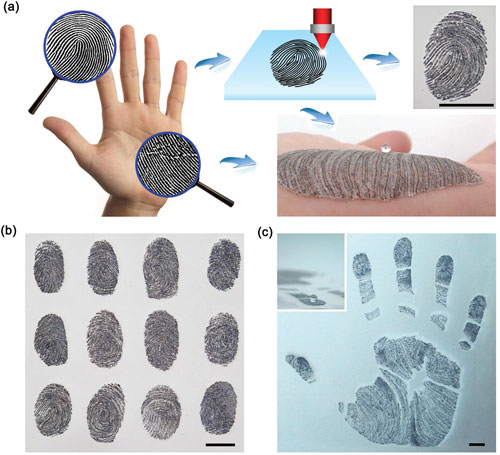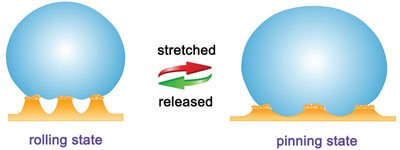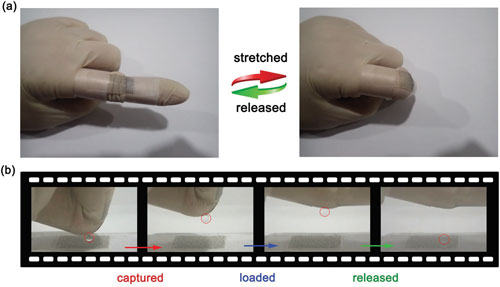| Posted: Apr 24, 2018 | |
A second skin with switchable wettability |
|
| (Nanowerk Spotlight) Creating smart superhydrophobic (i.e. extremely water-repellent) surfaces is of increasing importance in cutting-edge applications such as self-cleaning, anti freezing, anticorrosion, anti biofouling, water/oil separation, and microfluidics. | |
| Smart surfaces enabling reversible switching among distinct wetting states have attracted enormous research interests. Already, advanced material engineering techniques can structure surfaces that allow dynamic tuning of their wettability all the way from superhydrophobic behavior to almost complete wetting. | |
| "With the capability of reversible and dynamic wettability control, smart surfaces hold great potential for intelligent utilizations, such as rewritable devices, adaptive materials, and cell capture; devices equipped with superhydrophobic interfaces are also promising for emerging flexible and wearable uses," Hong-Bo Sun, a professor in the Institute of Opto-Electronic Engineering at Tsinghua University, tells Nanowerk. "However, dewetting surfaces in wearable systems are usually attached merely as a protective layer. Wearable surfaces with dynamic wetting behavior are rarely reported. Therefore a critical challenge is how to tailor the surface dewetting properties by mimicking real skin and to realize the controllable switching by simple stimulations." | |
| In new work reported in Advanced Functional Materials ("Wearable Superhydrophobic Elastomer Skin with Switchable Wettability"), Sun and his collaborators demonstrate a skin-like superhydrophobic surface, which can be switched into different wetting properties by simple body motion. | |
| "This result is exciting since the active surface enables on-demand manipulation of water droplets without energy supply or external appliance," Yong-Lai Zhang, a professor in the State Key Laboratory of Integrated Optoelectronics at Jilin University, the leader of laser biomimetic fabrication group and co-author of the paper, points out. | |
 |
|
| a) Schematic illustration of the manufacture of skin-like wearable surface by direct laser writing technique. b) Laser-printed diverse fingerprints. c) Liquid repellent palm of a real hand size. (Reprinted with permission by Wiley-VCH Verlag) | |
| Such a wearable, skin-like surface is promising for versatile applications like portable/wearable actuators, adaptive control of interface properties, liquid repellent skin, and smart clothing. | |
| The team employed a direct laser writing (DLW) technique to generate large-scale programmable skin-like textures on PDMS elastomer as their base material. The resulting flexible surface containing hierarchical micro- and nanostructures is extremely water repellent and skin conformable. | |
| The surface topography can be finely regulated in a rapid, reversible, and mild manner by simple stretching, providing the feasibility of controlling the surface wettability by simple body motions. | |
 |
|
| This figure illustrates the pinning model based on the reconfiguration of the surface, which enables wettability switching. (Reprinted with permission by Wiley-VCH Verlag) | |
| Research in advanced materials is full with examples where engineers mimic natural intelligence to devise advanced materials and capable systems. Naturally evolved surface structures on plants and animals have resulted in functional and adjustable skins, making them highly adaptive to the environment. For example, lotus leaves are extremely water repellent and self-cleaning; gecko feet can effortlessly attach to or detach from various surfaces. | |
| "In the past, we have successfully created biomimetic surfaces with similar properties," notes Sun. "Nowadays, we try to make them 'smart', i.e. tunable and responsive to external stimuli. What is more, we want to endow our skin or our clothing with such unique dewetting properties." | |
| To combine dynamic tuning of wetting properties with wearable applications, many issues need to be addressed. A key challenge is how to tailor the surface properties by mimicking real skin and to realize the controllable switching by simple body motions. | |
| As a typical example, Zhang illustrates that the smart artificial skin can be applied to the joints of fingers – as a 'tweezer on finger' – to capture and release of droplets by finger motions without requiring energy supply or external appliance. "The wearable smart skin would lead to versatile utilizations such as wearable manipulator, portable actuator, adaptive adhesion control, liquid repellent skin, and smart clothing." | |
 |
|
| a) Exertion and release of a strain on the wearable surface by human motions. b) 'Tweezer on finger' demonstrating capture, transfer, and release of a water droplet. (Reprinted with permission by Wiley-VCH Verlag) (click on image to enlarge) | |
| "In the future, devices and systems will be more and more 'smart', capable of realizing more complex functions through simpler ways," Sun concludes. "However, the realization of the functional integration in a simple and human-friendly manner is still challenging." | |
 By
Michael
Berger
– Michael is author of three books by the Royal Society of Chemistry:
Nano-Society: Pushing the Boundaries of Technology,
Nanotechnology: The Future is Tiny, and
Nanoengineering: The Skills and Tools Making Technology Invisible
Copyright ©
Nanowerk LLC
By
Michael
Berger
– Michael is author of three books by the Royal Society of Chemistry:
Nano-Society: Pushing the Boundaries of Technology,
Nanotechnology: The Future is Tiny, and
Nanoengineering: The Skills and Tools Making Technology Invisible
Copyright ©
Nanowerk LLC
|
|
|
Become a Spotlight guest author! Join our large and growing group of guest contributors. Have you just published a scientific paper or have other exciting developments to share with the nanotechnology community? Here is how to publish on nanowerk.com. |
|
